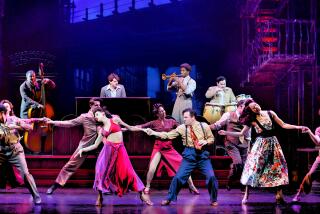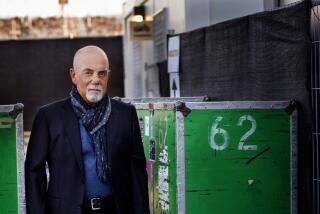A Grand Parade of Popular Song
- Share via
The recording is from 1911; the song itself from 1903. George M. Cohan’s barking voice sounds uninflected and far away but his energy jumps out, vaulting over the years. He’s rhapsodizing about a new kind of music he was instrumental in creating, a genre he identifies as the “popular melody craze.” He sings, demanding to no one in particular:
I want to hear a Yankee Doodle tune
Played by a military band.
I want to hear a Yankee Doodle tune
It’s the only music I can understand . . .
This is the first cut on this enjoyable and encompassing four-disc collection. Cohan’s song--in which he complains of music that’s “over-rated,” “pretentious” and “complicated”--perfectly sets the tone for this arching overview of the musical.
Compiled and helpfully annotated by Dwight Bowers and Amy Henderson, the collection pays special attention to those defining characteristics of the American musical that Cohan celebrates and that were invented in opposition to European traditions that seemed stuffy and restrictive. This is a timeline of American popular song, emphasizing its energy, sentimentality, approval of earthly ambition and, most particularly, its uncomplicated relationship to pleasure. There are 81 songs in all, spanning shows and movies from 1903 to 1994.
Ethel Merman singing “Doin’ What Comes Natur’lly” from “Annie Get Your Gun” perfectly embodies the musical’s love of common sense, low jokes, good timing and blazing energy. The 14-year-old Judy Garland, singing in the 1936 movie “Pigskin Parade,” had already and mastered the strength/vulnerability dialectic she would make world famous.
The more fussy, operatic tradition is represented by Jeanette MacDonald and Nelson Eddy (“Indian Love Call”) and Gertrude Lawrence (“My Ship”), which is immediately followed by the more muscular, modern Lena Horne (“Just One of Those Things”).
Of course one can always quibble with choices on a collection of this nature. But why give us two Liza Minnelli cuts and not one Barbra Streisand or Judy Holliday?
Still, the pleasures are many, and, in the more obscure early material, surprising (though the inclusion of lyrics would have been helpful). In the final two discs we follow the musical embracing wider themes and more brittle world views while retaining its euphoria quotient. Just listen to “A Little Priest” from “Sweeney Todd” and “Waiting for the Girls Upstairs” from “Follies” and you’ll remember why Stephen Sondheim gets credited with reinventing the form. Even overly familiar songs such as “Send in the Clowns” resume their importance when heard in the vast context this collection provides.
More to Read
The biggest entertainment stories
Get our big stories about Hollywood, film, television, music, arts, culture and more right in your inbox as soon as they publish.
You may occasionally receive promotional content from the Los Angeles Times.










